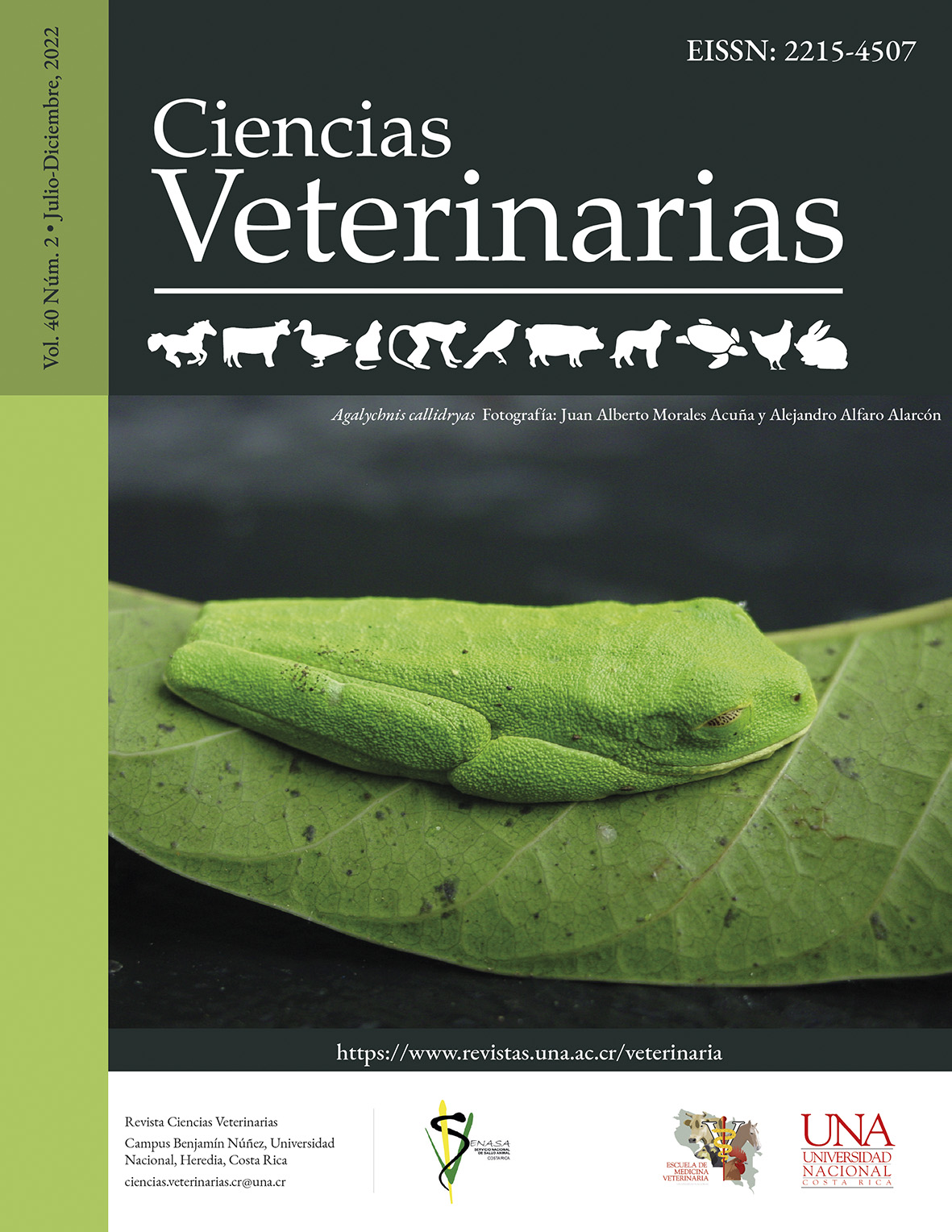Post mortem findings and bacterial characterization of equine salmonella septicemia. A case report
DOI:
https://doi.org/10.15359/rcv.40-2.2Keywords:
salmonella, equine, histopathology, bacterial characterizationAbstract
The first duly confirmed case of equine salmonellosis in Costa Rica is described, a seven-month-old Ibero-American filly with a four-week-long case of diarrhea and poor body condition. The presence of Salmonella enterica subspecies enterica was confirmed through a bacteriological study of stool samples. In the post-mortem study, severe extensive ulcerative and necrotizing typhlocolitis was observed.
References
Arroyo, L., Gómez, D. & Martins, C. (2018). Equine Duodenitis-proximal jejunitis: A review. Can Vet J. 59(5): 510–517. https://doi.org/10.1155/2020/7062408
Bousquet-Melou, A., Bernard, S., Schneider, M., & Toutain, P. L. (2002). Pharmacokinetics of marbofloxacin in horses. Equine veterinary journal, 34(4), 366–372. https://doi.org/10.2746/042516402776249191
Burgess, B. & Morley, P. (2014). Managing Salmonella in Equine Populations. Vet Clin Equine. 30(3): 623-640. https://doi.org/10.1016/j.cveq.2014.08.005
Grandolfo, E., Parisi, A., Ricci, A., Lourusso, E., De Siena, R., Trotta, A., Buonavoglia, D., Martella, V. & Corrente, M. 2018. High Mortality in foals associated with Salmonella enterica subsp enterica abortusequi infection in Italy. Journal of Veterinary Diagnostic Investigation. 30(3): 483-485. https://doi.org/10.1177/1040638717753965
Kirk MD, Pires SM, Black RE, Caipo M, Crump JA, Devleesschauwer B, Döpfer D, Fazil A, Fischer-Walker CL, Hald T, et al. (2015). World Health Organization Estimates of the Global and Regional Disease Burden of 22 Foodborne Bacterial, Protozoal, and Viral Diseases, 2010: A Data Synthesis. PLOS Medicine. 12(12):e1001921. https://doi.org/10.1371/journal.pmed.1001921
Kim S, Frye JG, Hu J, Fedorka-Cray PJ, Gautom R, Boyle DS. 2006. Multiplex PCR-Based Method for Identification of Common Clinical Serotypes of Salmonella enterica subsp. enterica. J Clin Microbiol. 44(10):3608–3615. https://doi.org/10.1128/JCM.00701-06
Knych, H. K., Arthur, R. M., McKemie, D. S., Baden, R. W., Seminoff, K., & Kass, P. H. (2021). Pharmacokinetics and anti-inflammatory effects of flunixin meglumine as a sole agent and in combination with phenylbutazone in exercised Thoroughbred horses. Equine veterinary journal, 53(1), 102–116. https://doi.org/10.1111/evj.13260
Lahiri Amit, Lahiri Ayan, Iyer N, Das P, Chakravortty D. (2010). Visiting the cell biology of Salmonella infection. Microbes and Infection. 12(11):809–818. https://doi.org/10.1016/j.micinf.2010.05.010
Leon, I., Lawhon, S., Norman, K., Treadhill, D., Ohta, N., Vinasco, J. & Scott, H. 2018. Serotype diversity and antimicrobial resistence among Salmonella enterica isolates from patients at an equine referral hospital. Appl Environ Microbiol. 84(13): 8-11. https://doi.org/10.1128/AEM.02829-17
Magdesian K. G. (2005). Neonatal foal diarrhea. The Veterinary clinics of North America. Equine practice, 21(2), 295–vi. https://doi.org/10.1016/j.cveq.2005.04.009
Manship, A., Blikslager, A., & Elfenbein, J. (2018). Disease features of equine coronavirus and enteric salmonellosis are similar in horses. J Vet Inter Med. 33 (2): 912-917. https://doi.org/10.1111/jvim.15386
Markey, B., Leonard, F., Archambault, M., Cullinane, A. & Maguire, D. (2013). Clinical Veterinary Microbiology. (2ed) Elsevier sounders. https://books.google.com/book/.about/.Clinical_Veterinary_Microbiology_E_Book.html?hl=es&id=FUJYAQAAQBAJ
Martelli F, Kidd S, Lawes J. (2018). Salmonella and salmonellosis in horses: an overview. Veterinary Record. 182(23):659–660. https://doi.org10.1136/vr.k2525
Shaw, S, & Stamfli, H. (2017). Diagnosis and treatment of undifferentiated and infectious acute diarrhea in the adult horse. Vet Clin Equine. 34(1): 39-53. https://doi.org/10.1016/j.cveq.2017.11.002
Stokol T. (2020). Hematology Red Flags: The Value of Blood Smear Examination in Horses. The Veterinary clinics of North America. Equine practice, 36(1), 15–33. https://doi.org/10.1016/j.cveq.2019.11.00
Waxman, S. J., KuKanich, B., Milligan, M., Beard, W. L., & Davis, E. G. (2012). Pharmacokinetics of concurrently administered intravenous lidocaine and flunixin in healthy horses. Journal of veterinary pharmacology and therapeutics, 35(4), 413–416. https://doi.org/10.1111/j.1365-2885.2011.01356.x
Published
How to Cite
Issue
Section
License
Licensing of articles
All articles will be published under a license:

Licencia Creative Commons Atribución-NoComercial-SinDerivadas 3.0 Costa Rica.
Access to this journal is free of charge, only the article and the journal must be cited in full.
Intellectual property rights belong to the author. Once the article has been accepted for publication, the author assigns the reproduction rights to the Journal.
Ciencias Veterinarias Journal authorizes the printing of articles and photocopies for personal use. Also, the use for educational purposes is encouraged. Especially: institutions may create links to specific articles found in the journal's server in order to make up course packages, seminars or as instructional material.
The author may place a copy of the final version on his or her server, although it is recommended that a link be maintained to the journal's server where the original article is located.
Intellectual property violations are the responsibility of the author. The company or institution that provides access to the contents, either because it acts only as a transmitter of information (for example, Internet access providers) or because it offers public server services, is not responsible.







